2000 FORD EXPLORER tow
[x] Cancel search: towPage 177 of 296
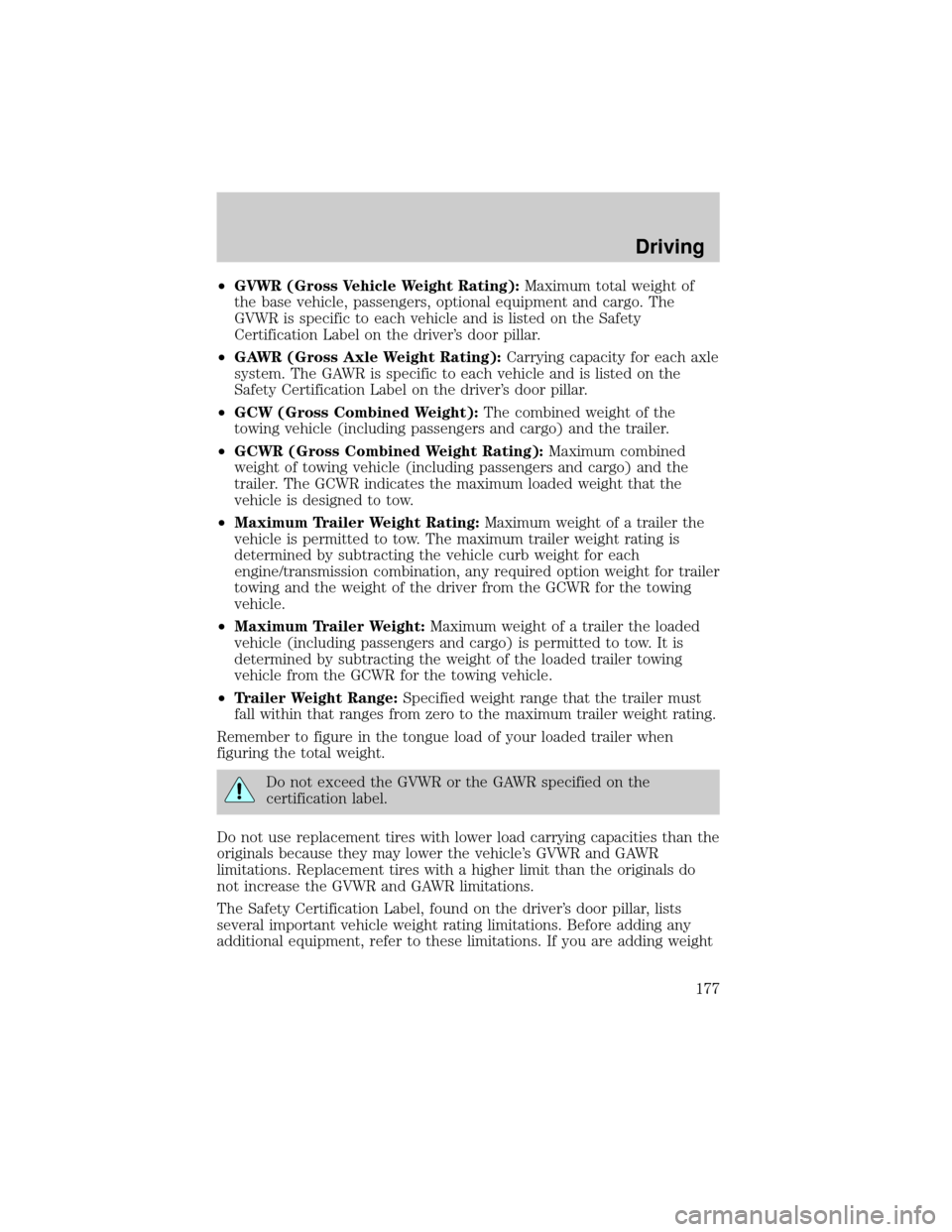
²GVWR (Gross Vehicle Weight Rating):Maximum total weight of
the base vehicle, passengers, optional equipment and cargo. The
GVWR is specific to each vehicle and is listed on the Safety
Certification Label on the driver's door pillar.
²GAWR (Gross Axle Weight Rating):Carrying capacity for each axle
system. The GAWR is specific to each vehicle and is listed on the
Safety Certification Label on the driver's door pillar.
²GCW (Gross Combined Weight):The combined weight of the
towing vehicle (including passengers and cargo) and the trailer.
²GCWR (Gross Combined Weight Rating):Maximum combined
weight of towing vehicle (including passengers and cargo) and the
trailer. The GCWR indicates the maximum loaded weight that the
vehicle is designed to tow.
²Maximum Trailer Weight Rating:Maximum weight of a trailer the
vehicle is permitted to tow. The maximum trailer weight rating is
determined by subtracting the vehicle curb weight for each
engine/transmission combination, any required option weight for trailer
towing and the weight of the driver from the GCWR for the towing
vehicle.
²Maximum Trailer Weight:Maximum weight of a trailer the loaded
vehicle (including passengers and cargo) is permitted to tow. It is
determined by subtracting the weight of the loaded trailer towing
vehicle from the GCWR for the towing vehicle.
²Trailer Weight Range:Specified weight range that the trailer must
fall within that ranges from zero to the maximum trailer weight rating.
Remember to figure in the tongue load of your loaded trailer when
figuring the total weight.
Do not exceed the GVWR or the GAWR specified on the
certification label.
Do not use replacement tires with lower load carrying capacities than the
originals because they may lower the vehicle's GVWR and GAWR
limitations. Replacement tires with a higher limit than the originals do
not increase the GVWR and GAWR limitations.
The Safety Certification Label, found on the driver's door pillar, lists
several important vehicle weight rating limitations. Before adding any
additional equipment, refer to these limitations. If you are adding weight
Driving
177
Page 178 of 296

to the front of your vehicle, (potentially including weight added to the
cab), the weight added should not exceed the front axle reserve capacity
(FARC). Additional frontal weight may be added to the front axle reserve
capacity provided you limit your payload in other ways (i.e. restrict the
number of passengers or amount of cargo carried).
Always ensure that the weight of passengers, cargo and equipment being
carried is within the weight limitations that have been established for
your vehicle including both gross vehicle weight and Front and rear
gross axle weight rating limits. Under no circumstance should these
limitations be exceeded. Exceeding any vehicle weight rating limitation
could result in serious damage to the vehicle and/or personal injury.
Special loading instructions for owners of pickup trucks and
utility-type vehicles
For important information regarding safe operation of this type
of vehicle, see thePreparing to drive your vehiclesection in
theDrivingchapter of this owner guide.
Loaded vehicles, with a higher center of gravity, may handle
differently than unloaded vehicles. Extra precautions, such as
slower speeds and increased stopping distance, should be taken when
driving a heavily loaded vehicle.
Your vehicle has the capability to haul more cargo and people than most
passenger cars. Depending upon the type and placement of the load,
hauling cargo and people may raise the center of gravity of the vehicle.
Calculating the load your vehicle can carry/tow
1. Use the appropriate maximum gross combined weight rating (GCWR)
chart to find the maximum GCWR for your type engine and rear axle
ratio.
2. Weigh your vehicle as you customarily operate the vehicle without
cargo. To obtain correct weights, try taking your vehicle to a shipping
company or an inspection station for trucks.
3. Subtract your loaded vehicle weight from the maximum GCWR on the
following charts. This is the maximum trailer weight your vehicle can tow
and must fall below the maximum shown under maximum trailer weight
on the chart.
Driving
178
Page 179 of 296

DRIVING THROUGH WATER
Do not drive quickly through standing water, especially if the depth is
unknown. Traction or brake capability may be limited and if the ignition
system gets wet, your engine may stall. Water may also enter your
engine's air intake and severely damage your engine.
If driving through deep or standing water is unavoidable, proceed very
slowly. Never drive through water that is higher than the bottom of the
hubs (for trucks) or the bottom of the wheel rims (for cars).
Once through the water, always try the brakes. Wet brakes do not stop
the vehicle as effectively as dry brakes. Drying can be improved by
moving your vehicle slowly while applying light pressure on the brake
pedal.
Driving through deep water where the transmission vent tube is
submerged may allow water into the transmission and cause
internal transmission damage.
TRAILER TOWING
Trailer towing with your vehicle may require the use of a trailer tow
option package.
Trailer towing puts additional loads on your vehicle's engine,
transmission, axle, brakes, tires, and suspension. For your safety and to
maximize vehicle performance, be sure to use the proper equipment
while towing.
Follow these guidelines to ensure safe towing procedure:
²Stay within your vehicle's load limits.
²Thoroughly prepare your vehicle for towing. Refer toPreparing to
towin this chapter.
²Use extra caution when driving while trailer towing. Refer toDriving
while you towin this chapter.
²Service your vehicle more frequently if you tow a trailer. Refer to the
severe duty schedule in the scheduled maintenance guide.
²Do not tow a trailer until your vehicle has been driven at least 800 km
(500 miles).
²Refer to the instructions included with towing accessories for the
proper installation and adjustment specifications.
Driving
179
Page 180 of 296
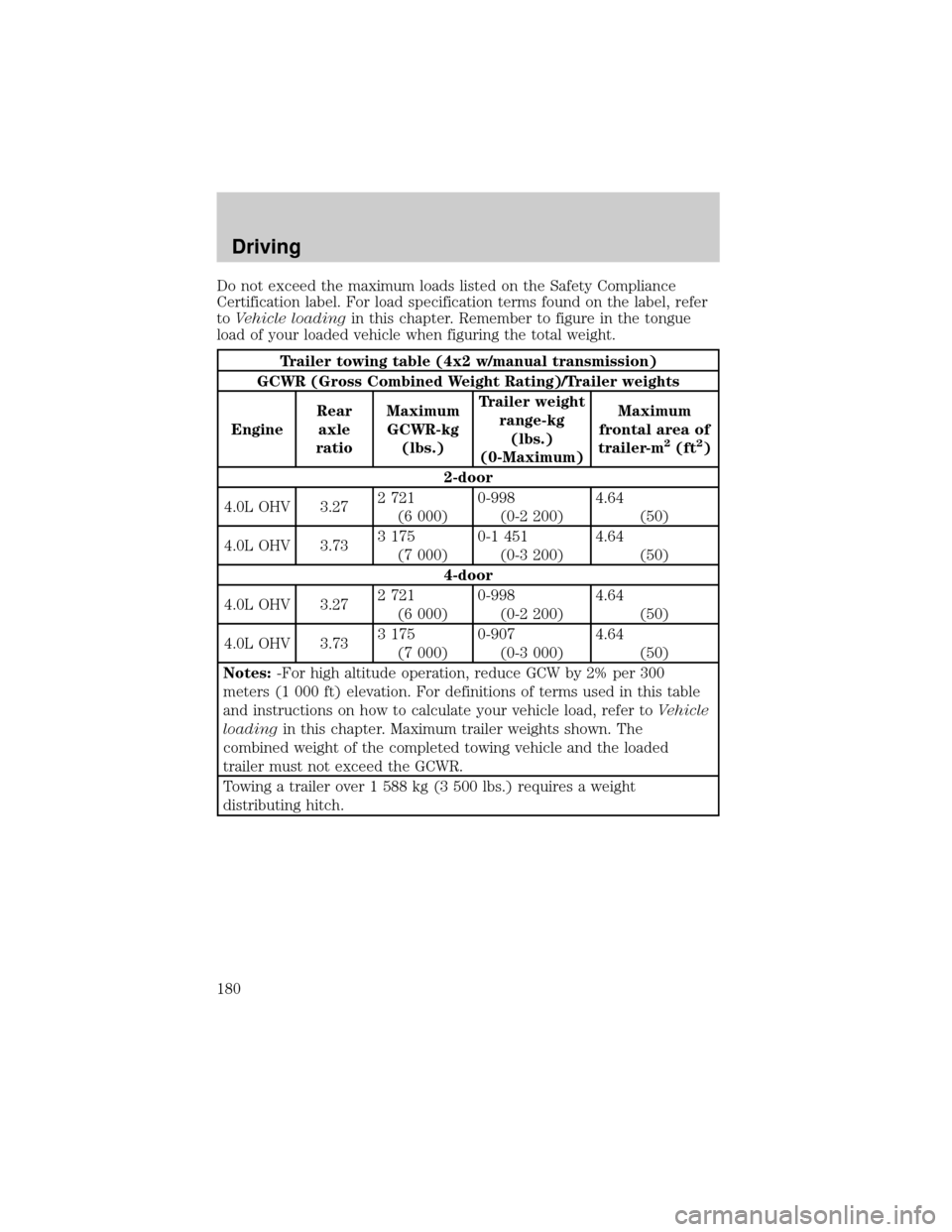
Do not exceed the maximum loads listed on the Safety Compliance
Certification label. For load specification terms found on the label, refer
toVehicle loadingin this chapter. Remember to figure in the tongue
load of your loaded vehicle when figuring the total weight.
Trailer towing table (4x2 w/manual transmission)
GCWR (Gross Combined Weight Rating)/Trailer weights
EngineRear
axle
ratioMaximum
GCWR-kg
(lbs.)Trailer weight
range-kg
(lbs.)
(0-Maximum)Maximum
frontal area of
trailer-m
2(ft2)
2-door
4.0L OHV 3.272 721
(6 000)0-998
(0-2 200)4.64
(50)
4.0L OHV 3.733 175
(7 000)0-1 451
(0-3 200)4.64
(50)
4-door
4.0L OHV 3.272 721
(6 000)0-998
(0-2 200)4.64
(50)
4.0L OHV 3.733 175
(7 000)0-907
(0-3 000)4.64
(50)
Notes:-For high altitude operation, reduce GCW by 2% per 300
meters (1 000 ft) elevation. For definitions of terms used in this table
and instructions on how to calculate your vehicle load, refer toVehicle
loadingin this chapter. Maximum trailer weights shown. The
combined weight of the completed towing vehicle and the loaded
trailer must not exceed the GCWR.
Towing a trailer over 1 588 kg (3 500 lbs.) requires a weight
distributing hitch.
Driving
180
Page 181 of 296
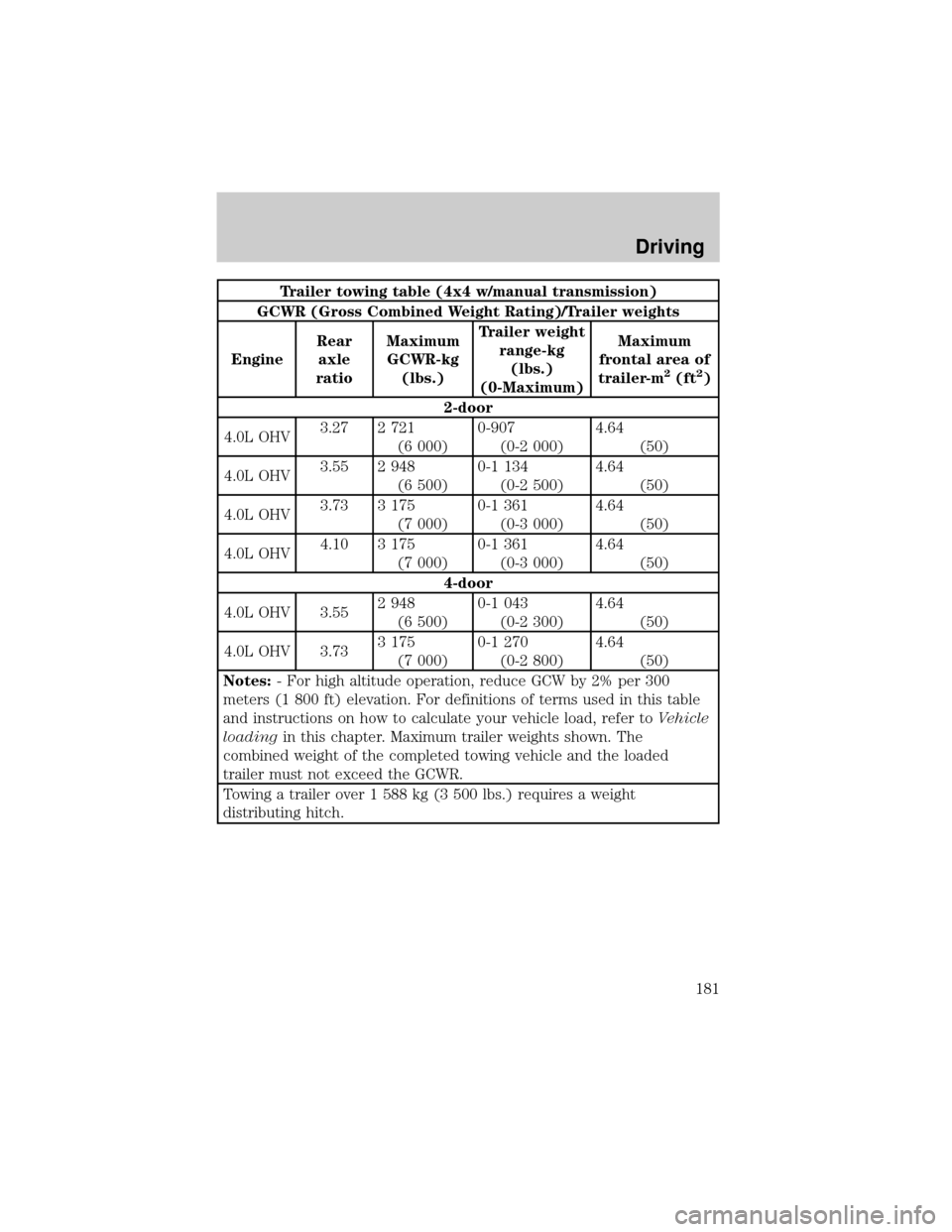
Trailer towing table (4x4 w/manual transmission)
GCWR (Gross Combined Weight Rating)/Trailer weights
EngineRear
axle
ratioMaximum
GCWR-kg
(lbs.)Trailer weight
range-kg
(lbs.)
(0-Maximum)Maximum
frontal area of
trailer-m
2(ft2)
2-door
4.0L OHV3.27 2 721
(6 000)0-907
(0-2 000)4.64
(50)
4.0L OHV3.55 2 948
(6 500)0-1 134
(0-2 500)4.64
(50)
4.0L OHV3.73 3 175
(7 000)0-1 361
(0-3 000)4.64
(50)
4.0L OHV4.10 3 175
(7 000)0-1 361
(0-3 000)4.64
(50)
4-door
4.0L OHV 3.552 948
(6 500)0-1 043
(0-2 300)4.64
(50)
4.0L OHV 3.733 175
(7 000)0-1 270
(0-2 800)4.64
(50)
Notes:- For high altitude operation, reduce GCW by 2% per 300
meters (1 800 ft) elevation. For definitions of terms used in this table
and instructions on how to calculate your vehicle load, refer toVehicle
loadingin this chapter. Maximum trailer weights shown. The
combined weight of the completed towing vehicle and the loaded
trailer must not exceed the GCWR.
Towing a trailer over 1 588 kg (3 500 lbs.) requires a weight
distributing hitch.
Driving
181
Page 182 of 296
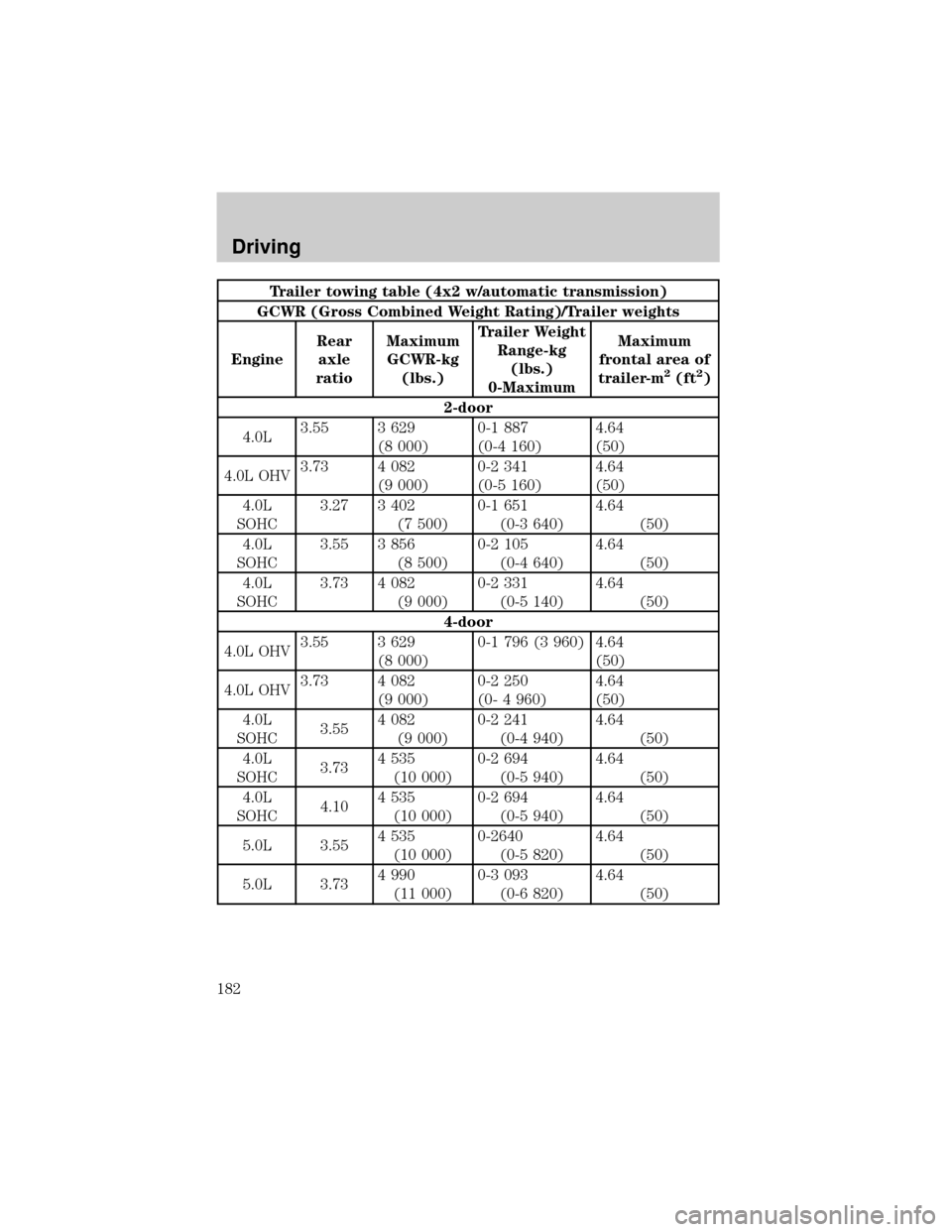
Trailer towing table (4x2 w/automatic transmission)
GCWR (Gross Combined Weight Rating)/Trailer weights
EngineRear
axle
ratioMaximum
GCWR-kg
(lbs.)Trailer Weight
Range-kg
(lbs.)
0-MaximumMaximum
frontal area of
trailer-m
2(ft2)
2-door
4.0L3.55 3 629
(8 000)0-1 887
(0-4 160)4.64
(50)
4.0L OHV3.73 4 082
(9 000)0-2 341
(0-5 160)4.64
(50)
4.0L
SOHC3.27 3 402
(7 500)0-1 651
(0-3 640)4.64
(50)
4.0L
SOHC3.55 3 856
(8 500)0-2 105
(0-4 640)4.64
(50)
4.0L
SOHC3.73 4 082
(9 000)0-2 331
(0-5 140)4.64
(50)
4-door
4.0L OHV3.55 3 629
(8 000)0-1 796 (3 960) 4.64
(50)
4.0L OHV3.73 4 082
(9 000)0-2 250
(0- 4 960)4.64
(50)
4.0L
SOHC3.554 082
(9 000)0-2 241
(0-4 940)4.64
(50)
4.0L
SOHC3.734 535
(10 000)0-2 694
(0-5 940)4.64
(50)
4.0L
SOHC4.104 535
(10 000)0-2 694
(0-5 940)4.64
(50)
5.0L 3.554 535
(10 000)0-2640
(0-5 820)4.64
(50)
5.0L 3.734 990
(11 000)0-3 093
(0-6 820)4.64
(50)
Driving
182
Page 183 of 296
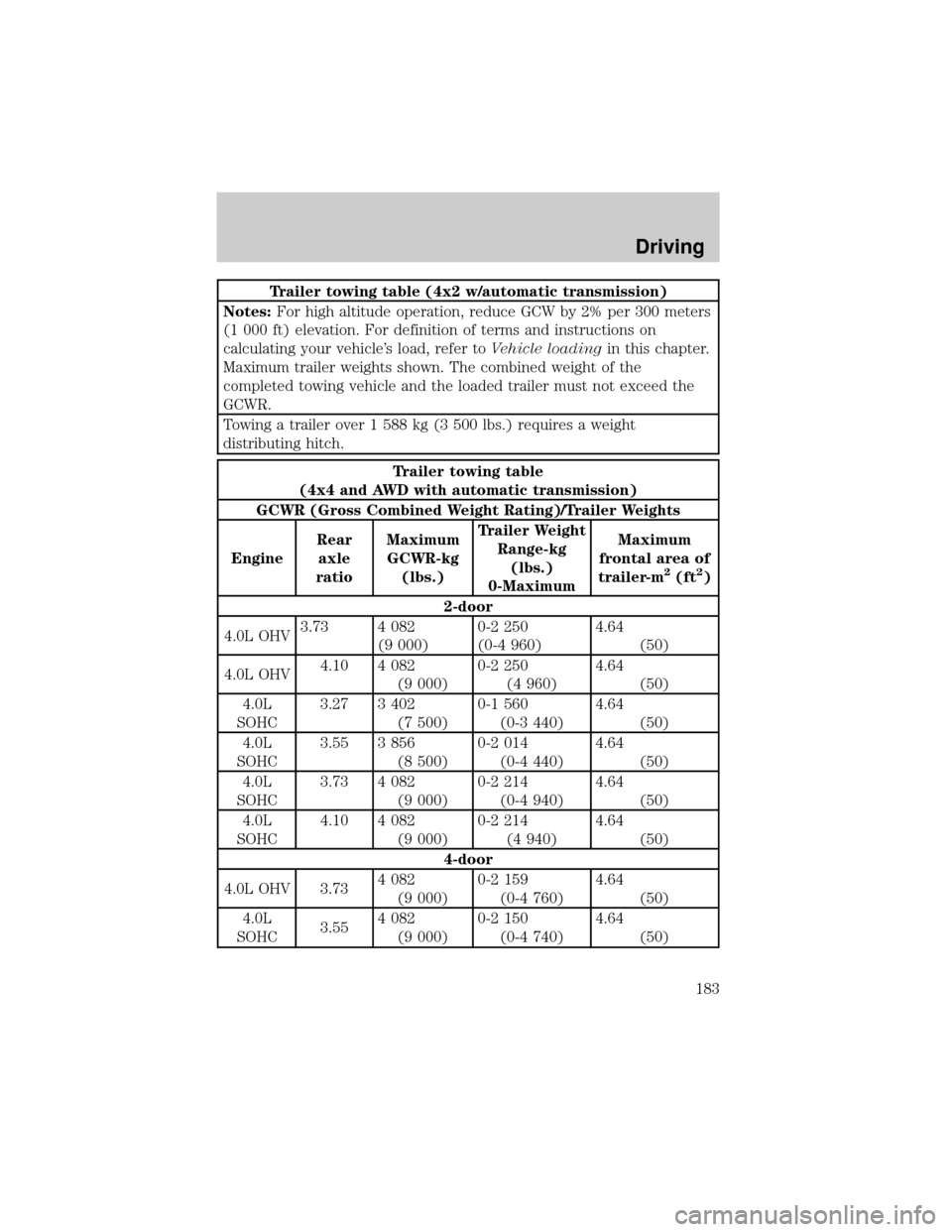
Trailer towing table (4x2 w/automatic transmission)
Notes:For high altitude operation, reduce GCW by 2% per 300 meters
(1 000 ft) elevation. For definition of terms and instructions on
calculating your vehicle's load, refer toVehicle loadingin this chapter.
Maximum trailer weights shown. The combined weight of the
completed towing vehicle and the loaded trailer must not exceed the
GCWR.
Towing a trailer over 1 588 kg (3 500 lbs.) requires a weight
distributing hitch.
Trailer towing table
(4x4 and AWD with automatic transmission)
GCWR (Gross Combined Weight Rating)/Trailer Weights
EngineRear
axle
ratioMaximum
GCWR-kg
(lbs.)Trailer Weight
Range-kg
(lbs.)
0-MaximumMaximum
frontal area of
trailer-m
2(ft2)
2-door
4.0L OHV3.73 4 082
(9 000)0-2 250
(0-4 960)4.64
(50)
4.0L OHV4.10 4 082
(9 000)0-2 250
(4 960)4.64
(50)
4.0L
SOHC3.27 3 402
(7 500)0-1 560
(0-3 440)4.64
(50)
4.0L
SOHC3.55 3 856
(8 500)0-2 014
(0-4 440)4.64
(50)
4.0L
SOHC3.73 4 082
(9 000)0-2 214
(0-4 940)4.64
(50)
4.0L
SOHC4.10 4 082
(9 000)0-2 214
(4 940)4.64
(50)
4-door
4.0L OHV 3.734 082
(9 000)0-2 159
(0-4 760)4.64
(50)
4.0L
SOHC3.554 082
(9 000)0-2 150
(0-4 740)4.64
(50)
Driving
183
Page 184 of 296
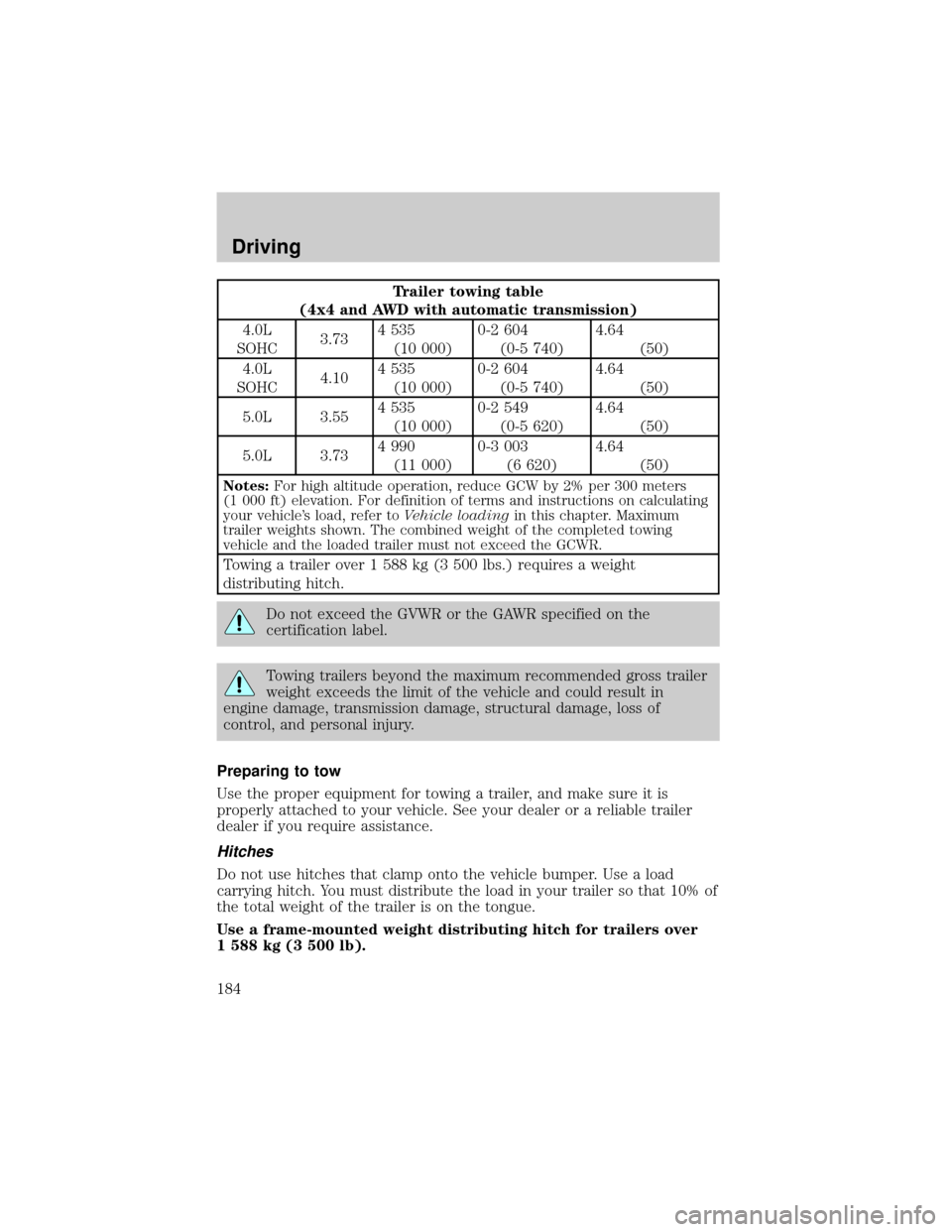
Trailer towing table
(4x4 and AWD with automatic transmission)
4.0L
SOHC3.734 535
(10 000)0-2 604
(0-5 740)4.64
(50)
4.0L
SOHC4.104 535
(10 000)0-2 604
(0-5 740)4.64
(50)
5.0L 3.554 535
(10 000)0-2 549
(0-5 620)4.64
(50)
5.0L 3.734 990
(11 000)0-3 003
(6 620)4.64
(50)
Notes:For high altitude operation, reduce GCW by 2% per 300 meters
(1 000 ft) elevation. For definition of terms and instructions on calculating
your vehicle's load, refer toVehicle loadingin this chapter. Maximum
trailer weights shown. The combined weight of the completed towing
vehicle and the loaded trailer must not exceed the GCWR.
Towing a trailer over 1 588 kg (3 500 lbs.) requires a weight
distributing hitch.
Do not exceed the GVWR or the GAWR specified on the
certification label.
Towing trailers beyond the maximum recommended gross trailer
weight exceeds the limit of the vehicle and could result in
engine damage, transmission damage, structural damage, loss of
control, and personal injury.
Preparing to tow
Use the proper equipment for towing a trailer, and make sure it is
properly attached to your vehicle. See your dealer or a reliable trailer
dealer if you require assistance.
Hitches
Do not use hitches that clamp onto the vehicle bumper. Use a load
carrying hitch. You must distribute the load in your trailer so that 10% of
the total weight of the trailer is on the tongue.
Use a frame-mounted weight distributing hitch for trailers over
1 588 kg (3 500 lb).
Driving
184